

 |
Search the Site with

|
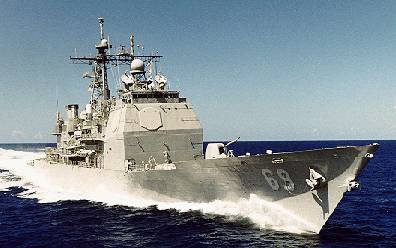
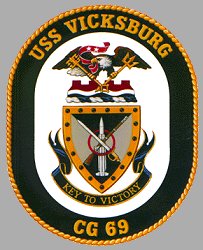
USS VICKSBURG is the 23rd TICONDEROGA-class guided missile cruiser and the 4th ship of the Navy to bear the name of the Mississippi city along the bluffs of the Mississippi River at the mouth of the Yazoo River.
| General Characteristics: | Awarded:February 25, 1988 |
| Keel laid: May 30, 1990 | |
| Launched: September 7, 1991 | |
| Commissioned: November 14, 1992 | |
| Builder: Ingalls Shipbuilding, West Bank, Pascagoula, Miss. | |
| Propulsion system: four General Electric LM 2500 gas turbine engines | |
| Propellers: two | |
| Blades on each Propeller: five | |
| Length: 567 feet (173 meters) | |
| Beam: 55 feet (16.8 meters) | |
| Draft: 34 feet (10.2 meters) | |
| Displacement: approx. 9,600 tons full load | |
| Speed: 30+ knots | |
| Cost: about $1 billion | |
| Aircraft: two | |
| Armament: two | |
| Homeport: Norfolk, Va. | |
| Crew: 33 Officers, 27 Chief Petty Officers and approx. 340 Enlisted |
Crew List:
This section contains the names of sailors who served aboard USS VICKSBURG. It is no official listing but contains the names of sailors who submitted their information.
USS VICKSBURG Cruise Books:
About the Ship's Coat of Arms:
 The Shield:
The Shield:
The shield's dark blue and gold are the colors traditionally associated with the United States Navy. Red is emblematic of sacrifice and valor. The blue and gray of the shield recall the two sides involved in the Civil War. The four sections underscore July 4, 1863, the date of the confederate surrender at Vicksburg, MS. The Naval sword and musket, crossed to express strength, signify the teamwork and the joint operations of the land and sea forces at Vicksburg when the Union Navy transported General Ulysses S. Grantís Army inland under fire. The annulet symbolizes General Grantís siege of the city by closing the ring on the Confederate forces to win the battle. The vertical missile symbolizes the firepower of the current cruiser, USS VICKSBURG. The border simulates the armor plates of the Civil War gunboats and the part they played in the battle; the seventeen black cannon balls pay tribute to the Unionís 17th Army Corps Commander who was victorious at Vicksburg, and was appointed Commander of the Vicksburg District on July 4, 1863.
The Crest:
In the crest, the American eagle in flight symbolizes the reunification of the states involved in the Civil War. The eagle carries a streamer containing the two battle stars of the previous cruiser, USS VICKSBURG (CL 86), received for service in World War II. The key held in the eagleís right talon represents President Abraham Lincolnís statement that "...Vicksburg is the key...the war can never be brought to a close until that key is in our pocket." The trident in the eagleís left talon is symbolic of a sea power with its three tines representing the anti-air, anti-surface, and anti-submarine warfare capabilities of the present guided missile cruiser, USS Vicksburg (CG 69). The trident also honors the previous ships named "VICKSBURG". The embattled wall above the wavy lines recalls the high fortresses of the city of Vicksburg along the east bank of the Mississippi River, and also represents defense, strength, and the combat capabilities of CG 69.
History of USS VICKSBURG:
Built by Ingalls Shipbuilding, at Pascagoula, MS, USS VICKSBURG's keel was laid on May 30, 1990 and she was launched on September 7, 1991. USS VICKSBURG was sponsored by Tricia Lott, wife of the Honorable Trent Lott, United States Senator, Mississippi. On October 12, 1991, Mrs. Lott christened CG 69 as "VICKSBURG". The ship was commissioned on November 14, 1992.
On her six month maiden deployment to the Mediterranean and Adriatic seas as a part of the USS SARATOGA joint task group, USS VICKSBURG operated as "redcrown" cruiser, an airspace deconfliction and command and control platform, in support of United Nations operations "Deny Flight", "sharp Guard" and "Provide Promise" off the coast of Montenegro. In May 1994, USS VICKSBURG participated, as part of the USS SARATOGA (CV 60) Battle Group, in the major annual spring NATO exercise "Dynamic Impact 94", a conventional major NATO exercise for maritime, amphibious, land based air and ground forces in the central and western Mediterranean area. The exercise was being held in the Western Mediterranean.
USS VICKSBURG was on station in the Florida Straits in August 1994 for Operation Able Vigil. While deployed, USS VICKSBURG was tasked with providing support to the interdicting and transporting Cuban migrants in the Florida Straits to U.S. Naval Station Guantanamo Bay, Cuba, and assisting the U.S. Coast Guard which had the primary responsibility for Operation Able Vigil.
As a precautionary measure, in September 1996, USS VICKSBURG was one of 13 Navy ships homeported at Naval Station Mayport, and sent to sea to avoid Hurricane Fran.
The USS VICKSBURG left its homeport on April 29, 1997 for a six-month overseas deployment with the USS JOHN F. KENNEDY (CV 67) Battle Group (CVBG) to relieve the USS THEODORE ROOSEVELT (CVN 71) CVBG, which had been operating in the Mediterranean Sea, Adriatic Sea, Red Sea and Persian Gulf. The USS JOHN F. KENNEDY (CV 67) Battle Group deployed in support of Operation Deliberate Guard and Operation Southern Watch. As part of that battle group, USS VICKSBURG took part, in July, in the 6th Fleet exercise Invitex involving 12 nations, and from September 23-October 7, in NATO'S Exercise Dynamic Mix. That exercise placed JOHN F. KENNEDY Battle Group units on opposing sides and was designed to increase task force and unit readiness as forces implemented NATO strategy and doctrine.
In 1998, USS VICKSBURG experienced significant problems with AEGIS Baseline 6.1 and CEC 2.0 integration, which forced re-scheduling its deployments and caused a major rework of these computer programs.
USS VICKSBURG took part in U.S. Baltic Operations (BALTOPS) '99 in the Western Baltic Sea in mid-1999. The exercise included 53 ships, submarines and aircraft from European allies and Partnership for Peace (PfP) nations Poland, Germany, France, United Kingdom, The Netherlands, Finland, Latvia, Sweden, Denmark, Estonia, Lithuania and the United States.
In the fall of 1999, USS VICKSBURG, participated solely in the modernized phase of the 40th annual UNITAS deployment to South America. During that deployment, it served as Flagship for the Commander, South Atlantic Force, U.S. Atlantic Fleet, and Commander, Destroyer Squadron Six. The 40th UNITAS was a three-week exercise was hosted by Brazil and included 23 ships from six countries, including the host, the United States, Argentina, Uruguay, Portugal and Spain.
USS VICKSBURG took part in September 2000 in Underway No. 10", one in a series of tests leading to the Cooperative Engagement Capability (CEC) Operation Evaluation (OPEVAL) scheduled for Spring 2001. The CEC system provides the capability to cooperatively engage targets by a warship using data from other CEC-equipped ships, aircraft, and land-based sensors, even in an electronic-jamming environment. It also provides a common, consistent and highly accurate air picture, allowing battle group defenses to act as one seamless system. The test, off Wallops Island, VA, simulated missile firings from some of the Navy's most technically advanced ships against unmanned drones.
From February 9, 2001, to March 2, 2001, USS VICKSBURG took part in a technical evaluation (TECHEVAL) to test whether the Cooperative Engagement Capability (CEC) was on track to a successful Operational Evaluation (OPEVAL) in April and May of 2001. The TECHEVAL was conducted in two phases, the first off the coast of Puerto Rico and the second off Wallops Island, Va. The tests included live missile firings and tracking exercises from some of the Navy's most technically advanced ships.
As part of the USS GEORGE WASHINGTON (CVN 73) Carrier Battle Group (CVBG), and in response to the terrorist attacks of September 11, 2001, USS VICKSBURG set sail in support of defense and humanitarian efforts off the coast of New York.
USS VICKSBURG, as part of the JOHN F. KENNEDY (CV 67) Battle Group (CVBG) participated in Joint Task Force Exercise (JTFEX) 02-1, with Phase I of the exercise running from January 19 through 26, 2002, and Phase II running from February 7-14.
USS VICKSBURG deployed as part of the USS JOHN F. KENNEDY Battlegroup, which relieved on March 8, 2002, the USS THEODORE ROOSEVELT (CVN 71) Carrier Battle Group, in support of Operation Enduring Freedom. USS VICKSBURG was tasked with helping protect the USS JOHN F. KENNEDY (CV 67) from threats in the sky, on the surface, or underwater.
Some Details:
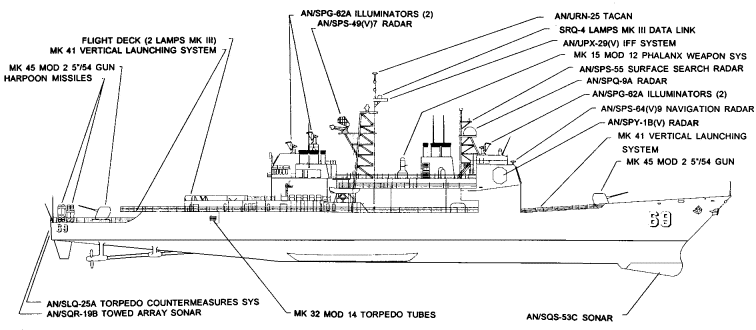
About the Cruiserís Name, about the Siege of Vicksburg:
Between Cairo IL, and the Gulf of Mexico, the Mississippi river meanders over a course of more than a thousand miles long. During the Civil War, control of this stretch of the river was of vital importance to the Federal Government. Command of that waterway would allow uninterrupted passage of Union troops and supplies into the South. It would also have the desired effect of isolating the states of Texas and Arkansas and most of Louisiana, comprising nearly half the land area of the Confederacy and a region upon which the South depended heavily for supplies and recruits.
From the beginning of the war in 1861, the Confederates, to protect this vital lifeline, erected fortifications at strategic points along the river. Federal forces, however, fighting their way southward from Illinois and northward from the Gulf of Mexico, captured post after post, until by late summer of 1862 only Vicksburg and Port Hudson posed major obstacles to Union domination of the Mississippi. Of the two posts, Vicksburg was the strongest and most important. It sat on a high bluff overlooking a bend in the river, protected by artillery batteries along the riverfront and by a maze of swamps and bayous to the north and south. President Abraham Lincoln called Vicksburg " the key" and believed that "the war can never be brought to a close until that key is in our pocket". So far the city had defied Union efforts to force it into submission.
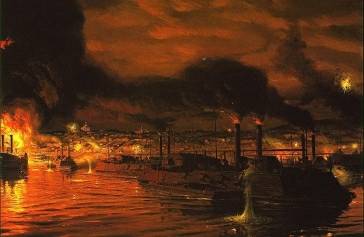 In October 1862, Ulysses S. Grant was appointed commander of the Department of the Tennessee and charged with clearing the Mississippi of Confederate resistance. That same month, Lt. Gen. John C. Pemberton, a West Point graduate and a Pennsylvanian by birth, assumed command of the roughly 50,000 widely scattered Confederate troops defending the Mississippi. His orders were to keep the river open. Vicksburg became the focus of military operations of both generals.
In October 1862, Ulysses S. Grant was appointed commander of the Department of the Tennessee and charged with clearing the Mississippi of Confederate resistance. That same month, Lt. Gen. John C. Pemberton, a West Point graduate and a Pennsylvanian by birth, assumed command of the roughly 50,000 widely scattered Confederate troops defending the Mississippi. His orders were to keep the river open. Vicksburg became the focus of military operations of both generals.
On March 31, 1863, Grant moved his army south from its encampments at Milliken's Bend, 20 miles northwest of Vicksburg. By April 28, the Northerners were established at hard Times on the Mississippi above Grand Gulf. On the 29th, RADM David D. Porter's gunboats bombarded the Confederate forts at Grand Gulf to prepare the way for a crossing, but the attack was repulsed. Undaunted, Grant marched a little further south and, on April 30, crossed unopposed at Bruinsburg.
Striking rapidly eastward to secure the bridgehead. The Northerners met elements of Pemberton's Confederate forces near Port Gibson on May 1. The Southerners fought a gallant holding action, but they were overwhelmed and fell back toward Vicksburg. After meeting and defeating a small Confederate force near Raymond on May 12, Grant's troops captured Jackson, the state capitol, on may 14, scattering Southern defenders.
Turning his army westward, Grant moved along the line of the Southern Railroad of Mississippi. At Champion Hill on May 16, and at Big Black River Bridge on May 17, his soldiers attacked and overwhelmed Pemberton's disorganized Confederates, driving them back into the Vicksburg fortifications. By May 18, advanced units of the Federal army were approaching the bristling Confederate defenses.
Believing that the battles of Champion Hill and Big Black River Bridge had broken Confederate morale, Grant immediately scheduled an assault on the Vicksburg lines. The first attack took place on May 19. It failed. A second attack, launched on the morning of May 22, was also repulsed.
Realizing that it was useless to expend further lives in attempts to take the city by storm, Grant reluctantly began formal sedge operations. Batteries of artillery were established to hammer the confederate fortifications from the land side, while Admiral Porter's gunboats cut off communications and blasted the city from the river. By the end of June, with little hope of relief and no chance to break out of the Federal cordon, Pemberton knew that it was only a matter of time before he must "capitulate upon the best attainable terms." On the afternoon of July 3, he met with Grant to discuss terms for the surrender of Vicksburg.
Grant demanded unconditional surrender; Pemberton refused. The meeting broke up. During the afternoon, the Federal commander modified his demands and agreed to let the Confederates sign paroles not to fight again until exchanged. In addition, officers could retain side arms and a mount. Pemberton accepted these terms, and at 10 a.m. on July 4, 1863 Vicksburg was officially surrendered.
USS VICKSBURG Patch Gallery:
 |  | 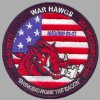 |
USS VICKSBURG Image Gallery:
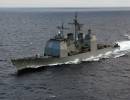 | 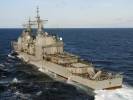 |  | 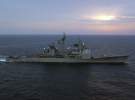 | 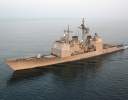 |
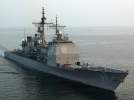 |  | 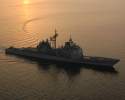 | 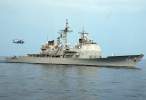 |
From June 2 - 18, 1999, USS VICKSBURG and USS HUE CITY (CG 66) participated in the 27th annual maritime exercise U.S. Baltic Operations (BALTOPS) 1999. On June 18, 1999 the ships arrived at Kiel, Germany, for a three-day port visit. During that port visit I took the following photos.
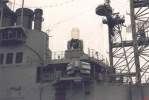 | 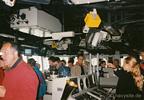 | 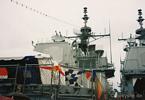 | 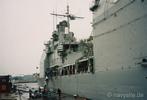 |  |
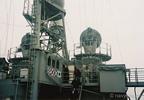 | 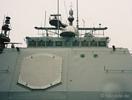 | 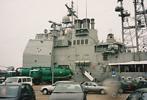 | 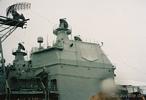 | 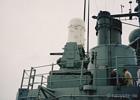 |
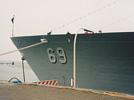 | 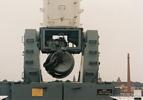 | 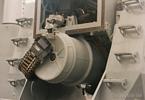 | 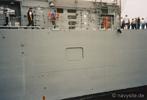 |  |
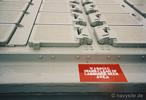 | 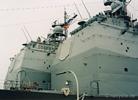 | 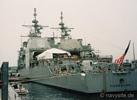 |
The photo below was taken by me on July 31, 2000, and shows the VICKSBURG at Naval Base Mayport, Fla.
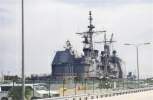 |
The photos below were taken by me and show the USS VICKSBURG at Naval Base Faslane, UK, on October 4, 2014, (the first three photos) prior to VICKSBURG's participation in Exercise Joint Warrior 142. For the exercise, the US Navy sent VICKSBURG, USS JASON DUNHAM (DDG 109) and USNS KANAWHA (T-AO 196) to Scotland. The other photos show the VICKSBURG departing Faslane in grim weather early in the morning of October 6.
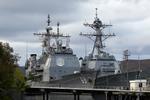 | 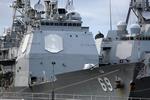 | 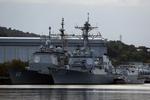 | 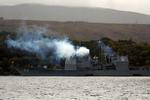 | 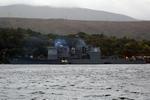 |
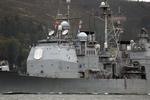 | 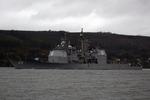 |  | 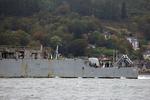 |  |
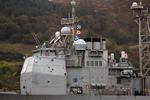 | 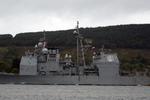 | 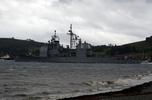 | 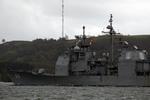 | 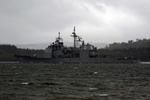 |
The photos below were taken by Philip Petersen and me and show the USS VICKSBURG alongside USS ANZIO (CG 68) and USS DONALD COOK (DDG 75) at Naval Base Faslane, UK, on April 11, 2015, (the first three photos) before participating in Exercise Joint Warrior 151. The other photos show the VICKSBURG departing Faslane on April 12, 2015. The VICKSBURG is presently serving as flagship of NATO's SNMG2.
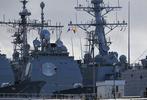 |  | 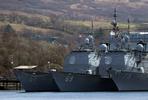 | 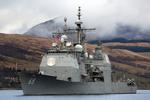 | 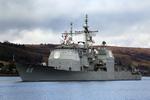 |
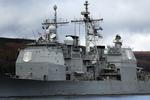 | 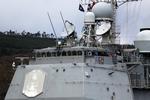 | 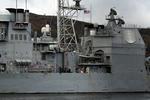 | 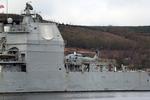 | 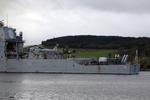 |
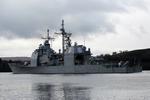 |
The photos below were taken by me and show the USS VICKSBURG arriving at Kiel, Germany, on June 19, 2015, after participating in BALTOPS 2015. She is still serving as flagship of NATO's SNMG2. The last photos show her later that day at Naval Base Kiel with USS JASON DUNHAM (DDG 109) alongside. Note that the previous Command Effectiveness Awards on the ship's bridge wings have been painted over on the arrival photos. On the latter photos at the Naval Base, the crew is applying the current awards.
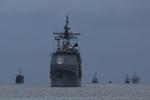 | 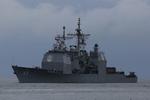 | 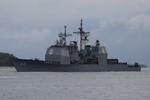 | 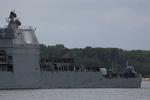 | 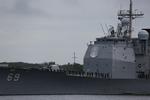 |
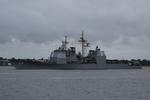 | 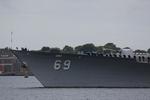 | 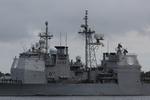 | 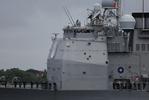 | 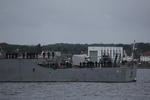 |
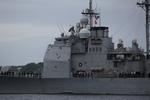 | 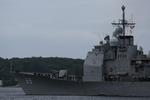 | 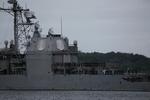 | 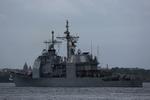 | 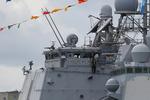 |
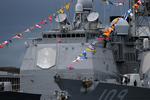 | 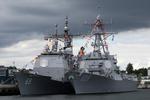 |
The photos below were taken by me on June 21, 2015, during an open house aboard USS VICKSBURG (CG 69) at Naval Base Kiel, Germany. The VICKSBURG visited Kiel after her participation in BALTOPS 2015.
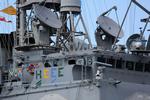 | 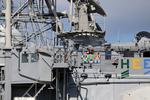 |  |  | 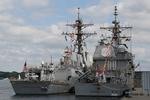 |
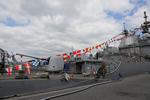 | 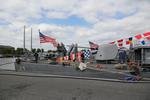 | 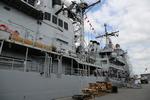 | Click here for more Photos. | |
The photos below were taken by Michael Jenning and show the VICKSBURG at Naval Base Norfolk, Va., on October 12, 2016. The VICKSBURG is presently involved in the Navy's Cruiser Phased Modernization Program which means that the ship is presently laid up and maintained by a small 45-person crew. The ship will later undergo modernization and return to service by 2022, replacing an older sistership. The VICKSBURG entered the program on July 1, 2016, at Mayport, Fla., and arrived at her new administrative homeport of Norfolk, Va., on July 8. The program follows a 2-4-6 plan meaning that each year no more than two cruisers will be placed in phased modernization; no cruiser will remain in phased modernization for more than 4 years; and no more than six cruisers may be in phased modernization at the same time.
 | 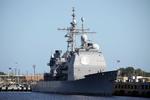 | 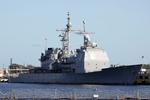 | 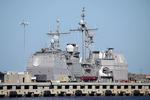 |
The photo below was taken by Michael Jenning and shows the VICKSBURG during her Special Selected Restricted Availability (SSRA) at BAE Systems Norfolk Ship Repair on October 4, 2017. The SSRA is part of the Navy's Cruiser Phased Modernization Program.
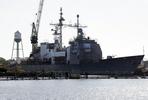 |
The photos below were taken by Michael Jenning and show the VICKSBURG at BAE Systems Norfolk Ship Repair on September 22, 2018.
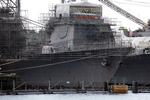 | 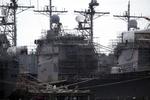 |
The photos below were taken by Michael Jenning and show the VICKSBURG undergoing a modernization period availability at BAE Systems Norfolk Ship Repair on December 26, 2021. VICKSBURG entered the shipyard on March 24, 2000.
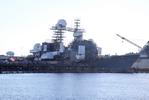 | 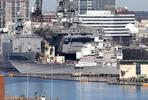 |
The photos below were taken by Michael Jenning and show the VICKSBURG undergoing a modernization period availability at BAE Systems Norfolk Ship Repair on September 6, 2022.
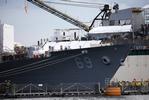 | 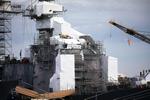 | 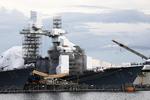 |
The photos below were taken by Michael Jenning and show the VICKSBURG at BAE Systems Norfolk Ship Repair on October 9, 2023. She is missing almost all of her sensors and weapons systems. The Navy is trying to retire the VICKSBURG for a few years now while lawmakers insisted on keeping her in the fleet. VICKSBURG has almost finished her modernization but presently it seems as if the Navy might be successful in retiring the ship. That would mean a massive waste of tax Dollars because according to Rep. Kay Granger, the Navy has already awarded nearly $500 million in contracts to upgrade the VICKSBURG.
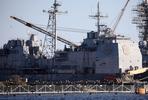 | 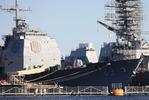 | 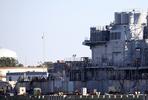 |  | 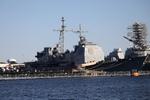 |
 Back to Cruisers list.
Back to Cruisers list.  Back to ships list.
Back to ships list.  Back to selection page.
Back to selection page.  Back to 1st page.
Back to 1st page.